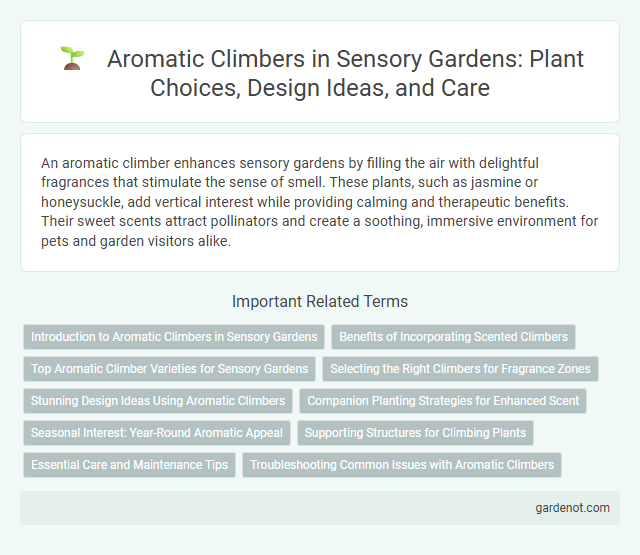An aromatic climber enhances sensory gardens by filling the air with delightful fragrances that stimulate the sense of smell. These plants, such as jasmine or honeysuckle, add vertical interest while providing calming and therapeutic benefits. Their sweet scents attract pollinators and create a soothing, immersive environment for pets and garden visitors alike.
Introduction to Aromatic Climbers in Sensory Gardens
Aromatic climbers such as jasmine, honeysuckle, and climbing roses enhance sensory gardens by providing fragrant scents that stimulate the olfactory senses. These plants thrive on trellises and arbors, creating vertical interest while releasing calming aromas throughout the garden space. Incorporating aromatic climbers supports therapeutic environments and attracts pollinators like bees and butterflies, enriching the garden's biodiversity.
Benefits of Incorporating Scented Climbers
Incorporating aromatic climbers in sensory gardens enhances the olfactory experience by releasing natural fragrances that stimulate the senses and promote relaxation. These scented plants attract pollinators such as bees and butterflies, supporting local biodiversity and improving garden health. Their vertical growth maximizes space efficiency, making them ideal for creating immersive, fragrant environments in limited areas.
Top Aromatic Climber Varieties for Sensory Gardens
Top aromatic climber varieties for sensory gardens include jasmine, honeysuckle, and clematis, renowned for their intense fragrances and vibrant blooms. Jasmine (Jasminum spp.) offers sweet, heady scents that attract pollinators and enhance outdoor sensory experiences. Honeysuckle (Lonicera spp.) produces nectar-rich flowers with a strong, pleasing aroma, while clematis varieties provide fragrant blossoms that add both visual and olfactory appeal to sensory garden spaces.
Selecting the Right Climbers for Fragrance Zones
Selecting the right aromatic climbers for fragrance zones enhances sensory gardens by providing continuous, natural scents that elevate the space's ambiance. Popular choices such as jasmine, honeysuckle, and sweet pea produce strong, pleasant fragrances that attract pollinators and encourage relaxation. Placement in high-traffic areas or near seating maximizes the olfactory experience, creating an immersive environment for visitors.
Stunning Design Ideas Using Aromatic Climbers
Aromatic climbers such as jasmine, honeysuckle, and star jasmine enhance sensory gardens by adding fragrant vertical interest and lush greenery. Strategic placement on trellises, pergolas, or arches creates immersive fragrant pathways and shaded retreats that stimulate the senses. Combining these climbers with contrasting foliage and colorful flowers elevates garden aesthetics while promoting a calming olfactory experience.
Companion Planting Strategies for Enhanced Scent
Aromatic climbers such as jasmine, honeysuckle, and clematis thrive when paired with companion plants like lavender, rosemary, and thyme, which enhance their natural fragrance through complementary scent profiles. These companion plants improve pollinator attraction and support climber health by repelling pests and enriching soil nutrients. Strategic placement in sensory gardens maximizes aromatic diffusion, creating immersive olfactory experiences that elevate the garden's therapeutic benefits.
Seasonal Interest: Year-Round Aromatic Appeal
Aromatic climbers offer year-round sensory engagement by releasing fragrant blooms in multiple seasons, enhancing the garden's olfactory landscape continuously. Their dense foliage and seasonal flowers attract pollinators such as bees and butterflies while providing textural interest throughout the year. Popular varieties like honeysuckle and jasmine deliver consistent aromatic appeal, making them essential for a dynamic sensory garden experience.
Supporting Structures for Climbing Plants
Supporting structures for aromatic climbing plants are essential to maximize growth and fragrance release in sensory gardens. Trellises, pergolas, and arbors provide sturdy frameworks for plants like jasmine, honeysuckle, and wisteria to ascend, ensuring optimal sunlight exposure and air circulation. Proper support enhances the visual appeal and accessibility of aromatic climbers, enriching the sensory experience with invigorating scents.
Essential Care and Maintenance Tips
Aromatic climbers thrive best in well-drained soil with consistent moisture, avoiding waterlogging to prevent root rot. Regular pruning encourages vigorous growth and enhances fragrance production, while feeding with a balanced fertilizer during the growing season promotes lush foliage and abundant blooms. Monitoring for pests such as aphids and spider mites ensures healthy plants and maintains the sensory appeal of the garden.
Troubleshooting Common Issues with Aromatic Climbers
Aromatic climbers like jasmine or honeysuckle may suffer from yellowing leaves due to overwatering or nutrient deficiencies, requiring soil adjustment and balanced fertilization. Pest infestations such as aphids and spider mites can hinder growth, necessitating regular inspection and organic pesticide application. Ensuring proper pruning and support helps prevent overcrowding and promotes healthy airflow, reducing the risk of fungal diseases in sensory gardens.
Aromatic climber Infographic

 gardenot.com
gardenot.com